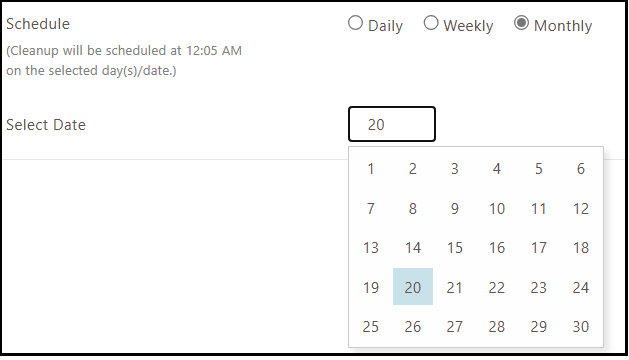KB007: Configure Device Cleanup Policies
Article ID: KB007
Last Updated: June 21, 2025
Applies To: HySecure Gateway 7.1 and above
Category: Administrative & Management
Overview
This guide explains how to configure automated cleanup of unused access devices. This feature automatically removes access devices that haven't been used for a specified number of days, improving device management and security by maintaining only active devices.
Prerequisites
- HySecure Gateway 7.1 or higher
- Security Officer or Administrator access to the HySecure Management Console
Benefits
- Simplified Device Management: Automatically remove inactive devices.
- Enhanced Security: Keep only active devices registered.
- Improved Performance: Reduce database overhead from stale device records.
- Flexible Scheduling: Configure cleanup frequency based on organizational needs.
How Device Cleanup Works
Tracking Mechanism
Last Login Time:
- Initially set when the service pack is first applied.
- Updates when the user logs in with the device.
- Used to calculate the device inactivity period.
Cleanup Criteria:
- Devices not used for a specified number of days.
- Automatic deletion during scheduled cleanup.
- Blocked devices remain unaffected.
Protected Devices
Devices NOT Removed:
- Currently blocked devices.
- Devices used within the configured retention period.
Procedure
Step 1: Access Cleanup Policies
-
Log in to Management Console
- Log in to the HySecure Management Console as a Security Officer or Administrator.
-
Navigate to Cleanup Policies
- Go to Diagnose > Cleanup Policies.
Step 2: Enable Access Device Cleanup
-
Enable Cleanup Feature
- Select the checkbox to enable Access Device cleanup.
-
Configure Retention Period
-
Set the Device not used since last value.
-
Specify the number of days after which the unused device will be deleted.
-
Example: Setting to 30 days will delete devices not used for 30+ days.
-
Step 3: Configure Cleanup Schedule
Choose one of the following scheduling options:
Option A: Daily Cleanup
-
Select Daily Schedule
- Choose the Daily option.
-
Configure Time
-
Set a specific time for daily cleanup.
-
Example: 02:00 AM for off-hours processing.

-
Option B: Weekly Cleanup
-
Select Weekly Schedule
- Choose the Weekly option.
-
Configure Days and Time
-
Select specific days of the week.
-
Set a time for cleanup execution.
-
Example: Wednesday and Friday at 12:05 AM.

-
Option C: Monthly Cleanup
-
Select Monthly Schedule
- Choose the Monthly option.
-
Configure Date and Time
-
Select a specific date of each month.
-
Set a time for cleanup execution.
-
Example: 20th of every month at a specified time.

-
Step 4: Save Configuration
-
Apply Settings
-
Review all configuration settings.
-
Click Save or Submit to apply changes.
-
-
Verify Configuration
-
Confirm the cleanup policy is enabled.
-
Verify schedule settings are correct.
-
Schedule Configuration Examples
Example 1: Daily Cleanup at Night
Schedule Type: Daily
Time: 02:00 AM
Retention Period: 90 days
Use Case: Organizations with high device turnover.
Example 2: Weekly Cleanup During Low Usage
Schedule Type: Weekly
Days: Wednesday, Friday
Time: 12:05 AM
Retention Period: 60 days
Use Case: Balanced cleanup frequency for medium-sized organizations.
Example 3: Monthly Cleanup for Large Organizations
Schedule Type: Monthly
Date: 20th of each month
Time: 03:00 AM
Retention Period: 180 days
Use Case: Large organizations with a stable device base.
Configuration Considerations
Retention Period Planning
Factors to Consider:
- User travel patterns and remote work.
- Device replacement cycles.
- Compliance and audit requirements.
- Business continuity needs.
Schedule Planning
Time Selection:
- Choose low-usage periods for cleanup.
- Consider time zones for global organizations.
Frequency Selection:
- Daily: High device turnover, tight security requirements.
- Weekly: Balanced approach for most organizations.
- Monthly: Conservative approach, stable device base.
Monitoring and Verification
Cleanup Execution Logs
Log Information:
- Cleanup execution time and date.
- Number of devices processed.
- Number of devices removed.
- Any errors or issues encountered?
Post-Cleanup Verification
Regular Monitoring:
- Review cleanup execution logs.
- Analyze device registration trends.
Important Notes
Initial Implementation
First-Time Setup:
- The last login time is initially set at the service pack installation.
- Existing devices get a baseline timestamp.
- Cleanup begins after the first scheduled execution.
User Impact:
- Users may need to re-register removed devices.
- Provide clear communication about the device lifecycle.
- Ensure the device registration process is streamlined.
Database Impact
Performance Benefits:
- Reduced device table size.
- Improved query performance.
- Lower storage requirements.
Backup Considerations:
- Device information is permanently deleted.
- Ensure backup strategies account for cleanup.
- Consider audit trail requirements.
Troubleshooting
Common Issues:
Cleanup Not Executing:
- Verify cleanup policy is enabled.
- Check the schedule configuration accuracy.
- Review system time and time zone settings.
Too Many Devices Removed:
- Review the retention period setting.
- Check if users are logging in regularly.
- Verify device usage patterns match expectations.
- Consider adjusting the retention period.